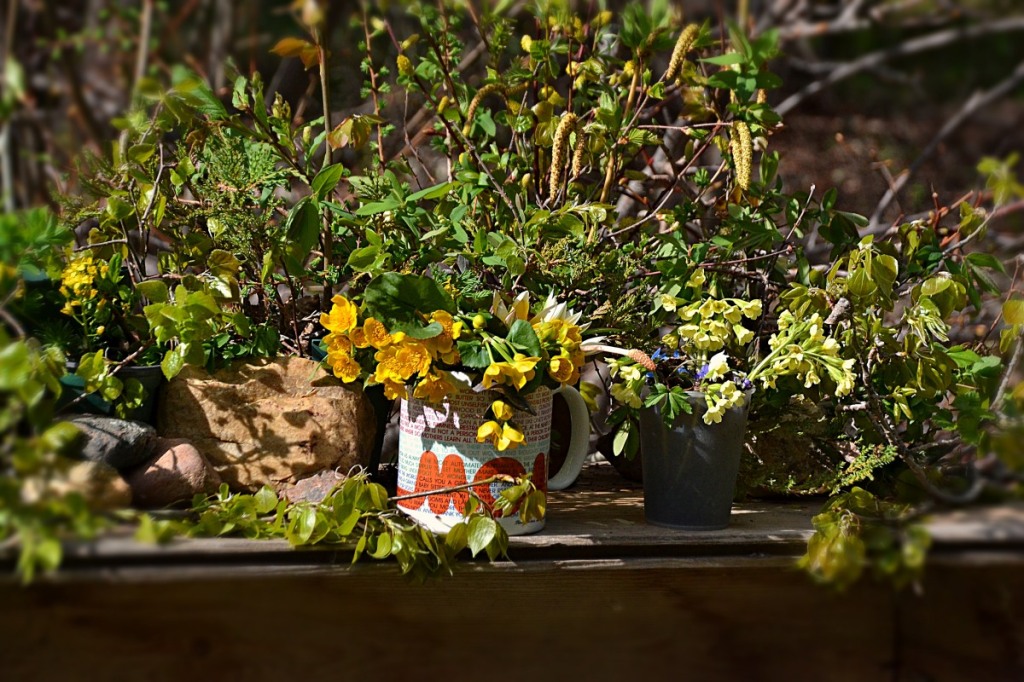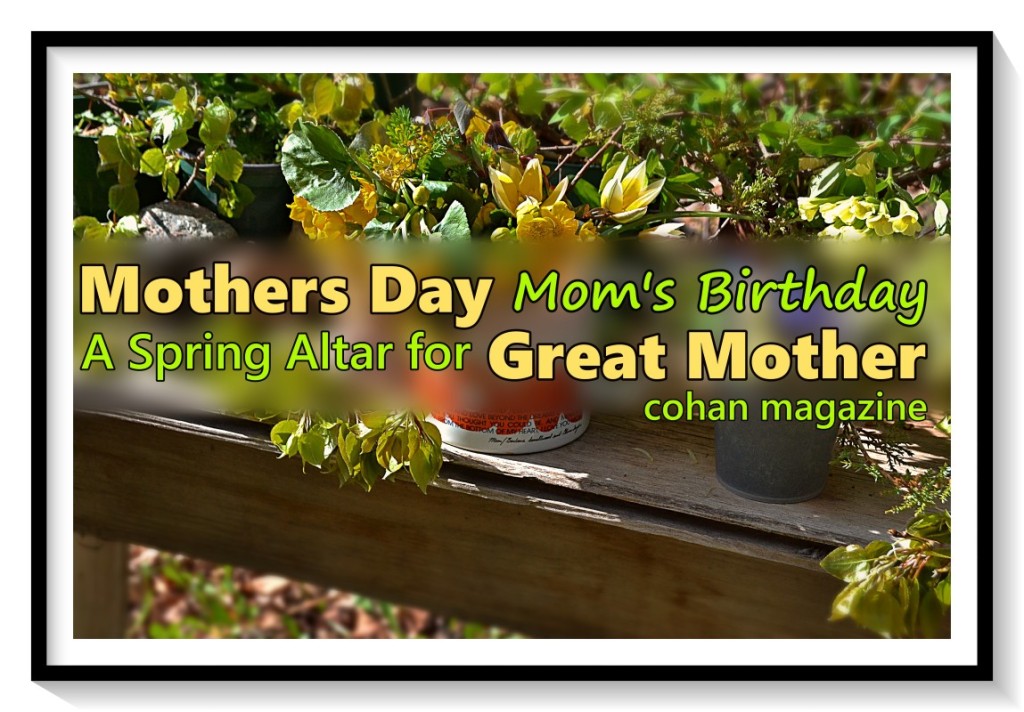We’ve just passed Mothers Day (Mother’s Day) and the anniversary of Mom’s birthday. When she was alive and I was home, starting in my youth, I’d pick a bouquet of the very earliest wildflowers, if I could find any! Originally that meant what we called Cowslips: Caltha palustris, Marsh Marigold- not to be confused with English Cowslips, Primula veris- I just call them Caltha now, there are other species, but not around here! In my teen years as I came to know the local plants more, I added in Sweet Coltsfoot/Petasites frigidus (esp ssp sagitattus). In slow springs I might be lucky to find a couple of stems of each, barely opening. In better years I could find plenty of each and maybe a few of the early violets: blue V. adunca and white V. renifolia.
When I moved back to help Mom in 2007, I resumed this practise (and learned that my Grandmother used to do the same thing for my Mother’s -and her twin’s!- birthday). As I built my gardens, adding spring flowers was key for me (long winters), and I began including early garden flowers in the Mother’s Day bouquet. I continued the practise after Mom’s death in 2018 (my aunt, her twin died a few years before, I think of them both) and have now expanded it to a general spring altar- a pagan / animist seasonal celebration of the Great Mother/Great Goddess/Mara (Ragana?*1-see the footnote that became as long as the blog 😄) /Bird Goddess- the primal Life force of Earth, generative, regenerative, partnering with Saule/Sun to renew life and growth in spring.
This year, the day after Mother’s Day, when I was off work, I spent a short time out on the farm collecting the Caltha along with willow and birch branches and a few horsetail stems, and enjoying the mild sunny day. Fluffy white clouds moved lazily in a blue sky over the slowly greening land. There were flies and bees on the flowers and lots of butterflies were about, though mostly not interested in posing. This time spent collecting is an important part of the altar laying, and I try to keep a sense of reverence and awe for the Nature/Divinity that surrounds me and that I am joyfully a part of. I gathered more branches- poplar, snowberry, honeysuckle etc- on the acreage and road allowance.


The altar consists of many branches ( and a few pots) of those trees and shrubs- new leaves just breaking out, some with catkins still in flower others near to releasing seed already- in the constant tumultuous cycle of life/death/rebirth! A potted native juniper cutting symbolising endless life Other than catkins, the first handful of native wildflowers are included- especially the Caltha mentioned above. Having been a rather dry early spring, or a dryish spring due to a dryish winter? (though our early summer rains seem to be beginning early?) the flowering has not been great on the Petasites, though the woodland P.f. palmatum is doing okay, it never flowers massively, so I did not include any in the bouquet/altar (though I will have a video where I search for and find them!). The two wild Violets mentioned earlier are flowering in good numbers- though they are tiny and fiddly to collect and display, I did include a handful each of V. adunca and V. renifolia from the acreage. Garden flowers included Anemone nemorosa, Draba aizoides, Glechoma hederacea, Primula elatior (not quite the other Cowslips, but close!), Tulipa tarda, Scilla sibirica and Corydalis aurea- actually a local native biennial, it romps around my gardens.

Here’s a video showing the preparation and laying of the altar, and the final results. This is a YouTube video, I’ll give the Spectra /Peertube link at the end.
As you can hear in the video, while I was building the altar a variety of birds were singing nearby- (American) Robin steadily belting out his tune high in a tree, Chickadees cheerfully singing their work songs as they foraged, Wren making a spring declaration, Crows endlessly socialising farther off. Meanwhile multitudes of frogs carolled their choruses from wetlands in several directions not too far away and pollinators were already visiting the plants on the bench. Songs of praise to Great Mother all around: the Living Goddess/Earth- she is the song, the singer, the audience, the stage, the subject and object.


I hope you had a lovely day with family if you celebrate in any way. For all of us, and especially those without loving connections to mothers (biological, adoptive or implicit!): may we remember and celebrate the soil, water, and air that gave birth to all of us, and without which we cannot thrive. Wishing a beautiful spring for those of you like me who are still in it, a gentle and fruitful entry to summer for those of you warmer, and a reflective and restorative winter for those on the other side!

Above we see a Birch tree-symbol of beginnings-and endings as they tend to be short-lived, renewal for they often sprout again from new shoots, nurturing for their early role in forest growth; so: motherhood, birth, death- all atributes of primal goddesses, such as Ragana who is associated with the tree, see the footnote that nearly became a post of its own🤣 below:
*1- Ragana: I’ve mentioned her before, and probably given at least part of this explanation, but my knowledge and thoughts on her origins and symbolism are gradually evolving. She’s an ancient Baltic goddess; this is the Latvian spelling, I think it should be Ragano or /os for Lithuanian, but can’t find a good reference as of this writing. She’s now considered a goddess of witches, of wild places, sometimes dangerous, especially to men. However given the presumed attitude of the later patriarchal Indo-Europeans to the apparent Old European goddess culture (matrilineal?) where the ancient earth goddesses were married off to male sky gods and/or melded with the goddesses of that pantheon, then even later the brutal misogyny of the Church, we can assume this to be rebranding. Yes, Ragana is a goddess of wild places- in the time of early human cultures, the whole world was ‘wild’ and primal nature deities would have been everything. Witches? Not the stuff of cartoons and horror stories (well, the Western witch hunting frenzy was a horror!) these were the Wise Women, herbalists, priestesses and keepers of ancient goddesses who remembered that they were a part of not apart from Nature. Women who understood, embodied and transmitted the knowledge that our bodies, our lives are extensions of the Great Mother. Not the property of princes, strongmen, husbands, fathers or the Church (an extension of the preceding). Of course these authority figures with their authority based on intimidation and ignorance drove the old ways to the wilds, outside civilised village and city life. Of course they labelled these women as dangerous or deranged- for the simple truths they lived were indeed dangerous to the repressive patriarchy. If people didn’t need permission to live from the powerful, if they didn’t need intermediaries to the divine, how would those who sought to concentrate power, control, wealth, continue to do so?
Ragana, symbol of nature, cycles of birth and death, of darkness balancing light, of divine generative (feminine) energy was too powerful to marry to one of the Indo-European gods, also too powerful to dismiss/ignore- so she was packed off to the wildnerness to be diminished, scorned, feared along with the powers and mysteries of the female body and a different way of being in the world. The hag she is presented as is a distortion- she should be the Wise Old Grandmother or Maiden Aunt- the lines on her face not a loss of male-envisioned beauty but rather the manifestation of decades of life-love, pleasure, hardship, experience, loss. And even all of that is but one aspect, for contained within the hag are the maiden-innocent, joyful, curious; and the matron- mother/caregiver, nurturer at the prime of her strength and practicality.
For a few years, I had been synonymising Mara/Great Mother with the most primal Earth Goddess/Bird Goddess- and I don’t think that is wrong. Still, Ragana may retain even more characteristics of that imagined First Goddess who culturally spawned so many later goddess/aspects. Just as the many Little Mother goddesses in Latvian culture may be seen to be separate or aspects of the Great Mother- or really, both things without contradiction, these ‘sister’ Great Goddesses can simultaneously represent the particular things they’ve come to be associated with and to form a unified whole-one great energy of Life/Earth encompassing myriad physical and spiritual forms, natural processes, cycles of seasons, birth, growth, senescence and death, soil, water, sunlight. May we feel the nurturing of the Great Mother, may we cherish the spirit of the Wild One, may she never be tamed.
Comments on the ease of reading on this platform are welcome. My original blog is on Blogger
You can find me on
If you are able and would like to support me, I have a Ko-fi page; support helps me keep working-more research, more writing, more art!
(see this post for musings on support sites: https://cohanmagazine.blogspot.com/2021/01/fiction-feedback-and-finances.html ).
As usual, if you love an image, it could be loaded to any of the print on demand sites as cards, prints, mugs, clothing etc. Haven’t played with any of those for a while, hope to get back at them soon.
Now, the Spectra video link I promised:

Leave a comment